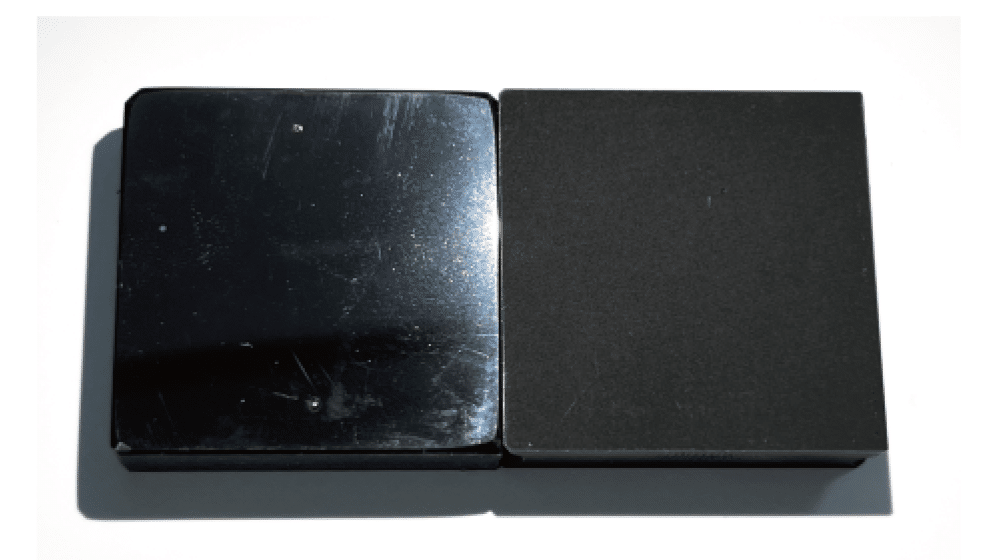- 01 Nasi's high-temperature oxidation-resistant light-absorbing coating application conditions
- 02 Can you provide light absorbing coating materials? How much does the coating cost?
- ▼ 03 Are there any mass-production customers for NANOX's high-temperature resistant oxidized coatings?
- 04 What is the difference between Naxx and other light-absorbing coatings on the market?
- ▼ 05 Can electromagnetic radiation be absorbed?
01 Nasi's high-temperature oxidation-resistant light-absorbing coating application conditions #
Nahshi'sDEB coatingThe DEB coating of Naxi is a R&D project that Lingxi has been following up for more than a year. There are two coating types, which are mainly for infrared and mid-infrared wavelength absorption, so they have a very good heat-absorbing effect, but with a film thickness of 3-7 micrometers and a metal-ceramic film, they basically don't affect the heat dissipation. Currently absorbance 0.82-0.88, by the metal substrate temperature limitations, suitable for different coating types. If you need to be similar to the knife tool coating as wear-resistant, the absorbance will be further reduced to 0.76.
The NACLEX DEB Absorbent Coating is based on a tool plating process, which provides a higher level of absorption compared to other decorative plating coatings.Binding force (HF1-HF2)The product is characterized by higher film hardness (800-2000HV), better high-temperature stability (theoretically 1100°C for 30 minutes; 750°C for 6-10 hours), and no decomposition and no vacuum precipitation at 700°C, -5pa.
This coating is currently only applicable to metals and is resistant to high temperatures above 250°C for 8 hours. For glass, ceramics and other substrates, the bonding force is less than 40mN, and the film is easy to come off.
| DEB | 0.84 | Multimeter insulation | 3-8μm | grayish black | laminate | 1800HV | 700-1000°C |
| CG9 | 0.88 | 20MΩ | 3-8μm | Black | laminate | 300HV | 250-300°C |
02 Can you provide light absorbing coating materials? How much does the coating cost? #
- Nasi DEB light-absorbing coating is a PVD vacuum coating process for incoming materials, where the workpiece is hang-plated in a vacuum furnace at 250-450°C, and PVD vacuum deposition is carried out.
- The price is calculated according to the amount of furnace. Usually 12,000-15,000 yuan a furnace; such as the largest size of the workpiece ≥ 800mm, plus 500 yuan outsourcing pre-treatment costs.
If you have the opportunity to proof with the oven, it is free of charge. - Currently, the maximum processing size is φ600x850mm, and for customers who do not require high light absorption and film thickness, the maximum size of the vacuum furnace can be expanded to φ680x1700mm.
- Specialized furnace, delivery time 2-3 days; sampling with the furnace, about 1 month due to irregular furnace opening.
▼ 03 Are there any mass-production customers for NANOX's high-temperature resistant oxidized coatings? #
Yes. Currently has four types of customers and is in the use secrecy stage. Currently, it is mainly used in high-power lamps, medical nuclear magnetic equipment, mid-infrared absorption, and deep-space light absorption. In addition, this coating is a high-temperature-resistant insulation, which can be used in nuclear power, base station parts, and so on.
04 What is the difference between Naxx and other light-absorbing coatings on the market? #
People are most likely to search for a materials research institute in Zhejiang, light absorption can be 99% above the ultra-black coating, "the coating can be deposited on the surface of a variety of substrates, at the same time can realize a large area of batch preparation, and can be adapted to high temperature, low temperature, vacuum, liquids and other extreme service environment."
Unfortunately Lingxi has not used them personally, but quite a few of my customers have approached them, and let's just say that the application working conditions are different. They describe their super black coating in terms of deposition and no weight gain, and the odds are that it is also a vacuum coating process. Ruoxi guesses that the commercially available coatings are more oriented towards decorative plating, so there will be a significant difference in high temperature resistance, abrasion resistance, bonding, and more complex working conditions. Usually, decorative plating lacks a priming layer and has a significant selection of substrates.
There is also a nanotube technology that achieves the ultra-black light-absorbing coating effect. Inspired by this, assuming that this light-absorbing coating is plated on a femtosecond or microscopic corrosion surface, the absorbance should be significantly increased. Making microstructures of metal surfaces currently has very good applications in hydrophobic coatings, similar to the lotus leaf effect. Similarly, there should be a very good practical effect in the field of light absorption, which allows the light to go through multiple rounds of reflection and diffuse reflection, and cuts down the spillage significantly.
NanoShield DEB coating is one of the few high-temperature oxidation-resistant light-absorbing coatings that has been mass-produced.
▼ 05 Can electromagnetic radiation be absorbed? #
Yes, nano-alumina is a typical infrared absorbing material. All kinds of rays are radiation, e.g. infrared rays are infrared radiation.
The larger the specific surface area of nano-alumina, the better the IR extinction effect. Suitable porosity and surface roughness will further enhance the absorption effect. NANOXI Light Absorbing Coating Series, more importantly, has a certain degree of abrasion resistance and high bonding force for industrial or special purposes, thus sacrificing part of the light absorption absorption energy.
For example, most of the infrared reconnaissance and guidance weapons operate in the 3-100μm band, and this coating has good extinction properties for infrared in this band. At the same time, due to the absorption of a large amount of radiant heat, it is usually necessary to have a good thermal conductivity of the metal substrate to quickly export the heat. Aluminum oxide itself has a melting point of 2054°C, so it has good heat resistance, but the heat-conducting substrate usually melts first, causing the coating to fail.
 Naxau Vacuum Coating Processing - Naxau AM
Naxau Vacuum Coating Processing - Naxau AM

